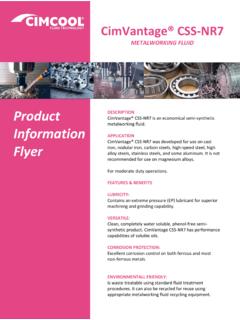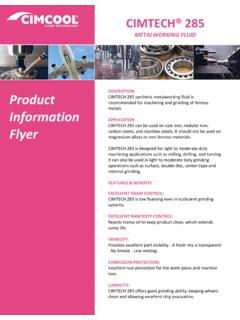Transcription of KATHON™ 886 MW Microbicide Metalworking …
1 KATHON 886 mw microbicide metalworking fluid Fungicide Microbicide for Water-Based Cutting Fluids Description Soluble, synthetic, and semi-synthetic Metalworking fluids or coolants provide an excellent environment for the growth of various microorganisms, including bacteria, mold, and yeast. If allowed to grow, these organisms can have detrimental effects on the fluids. For example, bacteria, which can grow very quickly, can destroy the integrity of the fluid by discoloration destroying lubricity characteristics, and causing emulsions to split. Bacteria can also reduce the pH of the fluid , which can promote corrosion. Some forms of bacteria have objectionable odors. Fungi typically grow more slowly than bacteria, but can form large masses which clog filters and lines and in some cases lead to system shutdown; fungi also generate foul odors and can cause corrosion. KATHON 886 MW Microbicide is very effective against bacteria and fungi. It is recommended for use in soluble, semi-synthetic, and synthetic Metalworking fluids.
2 Due to the wide variations in coolant formulations, laboratory or pilot tests are recommended to evaluate KATHON 886 MW Microbicide in specific Metalworking fluids prior to commercial use. KATHON 886 MW Microbicide is supplied as a 14% active liquid in water. It is registered with the EPA. (Environmental Protection Agency), number 707-129. Tankside Biocide KATHON biocides have been used safely and effectively in a variety of industries around the world for more than 20 years. In 1977 Rohm and Haas Company was granted EPA registration for KATHON 886 MW Microbicide for use in Metalworking fluids, in 2 piece can manufacture, hot aluminum rolling, and general machinery of ferrous and aluminum materials. In 1986, this registration was expanded to include the use of KATHON 886 MW Microbicide in metal cleaners and water-based hydraulic fluids. The information in this brochure has been compiled to familiarize users of KATHON 886 MW Microbicide with its chemistry, to communicate the tremendous benefits of this product as well as the potential hazards, to provide directions for safe and efficient use of the product, and to aid the user in the event of misuse.
3 Particular attention should be paid to the Compatibility section of this brochure which provides insight on the stability of KATHON 886. MW Microbicide with individual components and additives frequently used in Metalworking fluid operations. KATHON 886 MW Microbicide can be used safely and effectively by following the instructions and precautions outlined in this brochure, on the product label, and on the Rohm and Haas Material Safety Data Sheet. Key Features and Benefits of KATHON 886 MW. Table 1. Details the features and benefits of Kathon 886 MW. Features Benefits Highly effective Microbicide Extends Metalworking fluid life, resulting in reduced makeup fluid use and costs and lower waste fluid disposal costs Broad spectrum activity Provides long lasting and effective contamination prevention versus bacteria and fungi (no performance gaps). Efficacious versus specific Effective against Mycobacterium and endotoxin-producing bacteria problem-causing microorganisms (based on controlled laboratory studies).
4 Good temperature and pH stability Works well in a variety of Metalworking conditions up to 60 C. (140 F) and pH Highly soluble in water and Easy to dose does not foam Provides long lasting microbial control Cost effective versus competitive tankside treatments Fast acting Quickly controls microbial activity (oxygen consumption). and odor-causing bacteria and fungi Effective at low use rates Better for the environment (10 to 17 ppm ai) and biodegradable Does not contain or release formaldehyde Not subject to formaldehyde concerns Directions For Use Metalworking fluid Preservation For maintenance of a non-fouled system, use KATHON 886 MW Microbicide at fluid ounces ( pounds) per 1,000 gallons of emulsion every 4 weeks or fluid ounces ( pounds) per 1,000 gallons of emulsion every 8-12 weeks. For a noticeable fouled system use an initial dose of fl oz ( pounds) per 1,000. gallons of emulsion followed by subsequent maintenance dosages depending upon the treatment interval noted above.
5 A higher dosage range and/or increased frequency of treatment may be required depending upon rate of dilution of the preservative with makeup fluid , the nature and severity of contamination, level of control required, filtration effectiveness, and system design, etc. The preservative should be dispensed into the use dilution of the metal- working fluid using a metering pump and uniformly dispersed throughout the system. Metal Cleaning fluid Preservation KATHON 886 MW Microbicide is recommended as a preservative for the manufacture and use of alkaline, acid, and emulsion based metal cleaning fluids typically used in electroplating, phosphatizing, galvanizing, and general metal cleaning operations. For addition to a metal cleaning concentrate add KATHON 886 MW at a level to ensure that the final use-dilution fluid contains 44 to 147 ppm as supplied ( - 25 ppm active isothiazolones). When direct addition to a fouled system, add fl oz ( lbs) of Microbicide to each 1,000 gallons of use-diluted metal cleaning fluid every 3 to 4 weeks to provide 44 to 177 ppm as supplied ( to 25 ppm active isothiazolones).
6 A higher dosage range and/or increased frequency may be required depending upon dilution rate of the preservative with makeup fluid , the nature and severity of contamination, level of control required, filtration effectiveness, and system design, etc. The preservative should be dispensed into the use-dilution metal cleaning fluid using a metering pump and uniformly dispersed throughout the system. Water Based Hydraulic fluid Preservation KATHON 886 MW Microbicide is recommended as a preservative for use in the manufacture and use of high water- based hydraulic fluids and invert emulsion hydraulic fluids. For the maintenance of a nonfouled system, use KATHON 886 MW Microbicide at 9-13 fluid oz ( lbs) per 1,000 gallons of fluid every 8 weeks. For a noticeably fouled system use an initial dose of 13 to 20 fluid ounces ( lbs) per 1,000 gallons fluid followed by subsequent maintenance doses. A higher dosage range and/or increased frequency of treatment may be required depending upon rate of dilution of the preservative with makeup fluid , the nature and severity of contamination, level of control required, filtration effectiveness, system design, etc.
7 The preservative should be dispensed into the use-dilution of the hydraulic fluid using a metering pump and uniformly dispersed throughout the system. Table 2 provides minimum and maximum dosage levels of KATHON 886 MW for systems ranging from 500- 100,000 gallons. Table 2 Kathon 886 MW Use Rate System Size Minimum Maximum Gallons fl. oz (lbs.) fl. oz (lbs.). 500 ( ) ( ). 1000 ( ) 12 ( ). 2000 ( ) 25 ( ). 5000 14 ( ) 62 ( ). 10000 28 ( ) 123 (10). 25000 70 ( ) 308 (26). 50000 140 (12) 616 (52). 100000 280 (24) 1,232 (104). Minimum dose = 4 ppm active ingredient Maximum dose = ppm active ingredient Physical and Chemical Properties Table 3 Chemical Composition Ingredients KATHON 886 MW. Active 5-chloro-2-methyl-4-isothiazolin-3-one Ingredients 2-methyl-4-isothiazolin-3-one Total Active Ingredients (typical) Inert Ingredients Magnesium ion to %. (Approximate Water to 100%. Values). Table 4. Typical Physical Properties These properties are typical but do not constitute specifications.
8 Amber to gold, slightly Appearance viscous liquid Odor Mild, aromatic Specific Gravity, @ 25 C Density, pH 1 to 3. Viscosity, cps, @ 25 C 16. Melting Point, C 33. Boiling Point, C 100. Vapor Pressure, (mm Hg), @ 23 C. The typical physical properties of KATHON 886 MW Microbicide are presented in Table 2. Solubility KATHON 886 MW Microbicide is soluble in water, methanol, ethanol, isopropyl alcohol, acetic acid, and parts n- butanol. KATHON 886 MW Microbicide is insoluble in acetone. Stability pH - KATHON 886 MW Microbicide is stable over a wide pH range ( ) in water and Metalworking fluid systems. Its stability and performance are improved at lower pH. Whenever possible the pH of a system should be maintained below pH Storage - KATHON 886 MW Microbicide is stable as supplied for at least one year at ambient temperatures and at least six months at 50 C. Recommended Use Practices General Practices When Using KATHON Biocides Know the size of your system and dose at the recommended use levels.
9 To improve performance and longevity add KATHON 886 MW Microbicide on the clean side of the filters. It may be necessary to occasionally add KATHON 886 MW Microbicide to the dirty side of the filters if large populations of microorganisms are detected there. Minimize contamination: - Eliminate or minimize dead spots - Disconnect unused portions of the system - Do not throw trash in sumps Always remember to triple rinse (or equivalent) empty KATHON 886 MW containers to avoid incidental contact. Post placard with safety information and deactivation protocol near biocide handling area. Maximizing the Performance of KATHON 886 MW Fungicide Additional guidelines for maximizing the performance of KATHON 886 MW Microbicide are as follows: KATHON 886 MW Microbicide stability and performance is improved with lower pH. Whenever possible maintain the pH of system below pH Lower pH also makes amines and amine-containing compounds less aggressive. For systems with pH greater than , we strongly recommend determination of biological efficacy and chemical stability prior to use.
10 Avoid adding highly basic additives (alkaline materials with pH of 10-12) immediately prior to or after adding KATHON 886 MW Microbicide to your system. If a highly basic additive must be added, allow sufficient time (at least 30 minutes) between additions. Minimize levels of diethanolamine (DEA) in your system. If possible use 99% triethanolamine (TEA) or monoethanolamine (MEA) instead of DEA, and use these at as low a level as possible. Avoid use of mercaptans such as mercaptobenzothiazole. Some biocides are incompatible with KATHON 886 MW and can degrade it. To maintain performance avoid using Sodium Omadine and Triadine 10 with KATHON 886 MW Microbicide . If a fungicide is needed, use KATHON 893 MW fungicide; it is completely compatible with KATHON 886 MW Microbicide . Always add KATHON 886 MW Microbicide directly to the Metalworking fluid sump. Never use KATHON 886. MW Microbicide in a spray bottle. Avoid charging KATHON 886 MW Microbicide in high temperature zones, since increasing temperatures accelerate other degradation effects.











